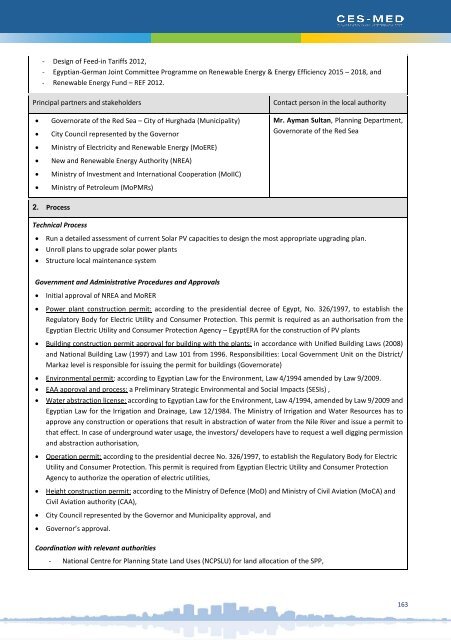020318_Hurghada SECAP_FINAL
You also want an ePaper? Increase the reach of your titles
YUMPU automatically turns print PDFs into web optimized ePapers that Google loves.
design and implement an adequate energy-retrofitting plan for residential buildings in the City of <strong>Hurghada</strong> -<br />
Governorate of Red Sea should engage in the following steps:<br />
- Assess the need through a detailed mapping of housing units, registering average energy consumption per<br />
square meter, date of construction and orientation,<br />
- Train small local companies that will have the flexibility to work in different type of conditions while performing<br />
adequate retrofitting programmes, the result in significant energy reduction,<br />
- Develop a partnership with a bank acting as a “third party investor” that will support the investment (for<br />
example through a process where the bank will cover the cost of the loan from a part of the savings allowed by<br />
the retrofitting programme),<br />
- Promote retrofitting in selected targets offering the best potential in terms of return on investment and,<br />
elaborating on these showcases further deploy the plan.<br />
LED lighting - Considering the pilot phase of 50 buildings representing 1000 housing units of similar capacity, and<br />
assuming each unit has 25 lamps, replacement requires 25,000 LED lamps. Given the cost of 75 EGP (3.62 € per lamp),<br />
the total cost for 1000 units amount to 1,875,000 EGP (90,000 €). These LED lamps would save at least 70% of the energy<br />
consumed for lighting (i.e. 20% of electricity consumption in residential buildings).<br />
An average housing unit consumes 4,575 kWh/y of which lighting is 915 kWh/y. Switching to LED cuts by 640 kWh/y.<br />
Electricity consumption reduction for 1000 units represents 640 MWh/y and avoids 351 tCO2eq/y.<br />
SWH Systems - One building represents in average 20 housing units occupied by 20 families, each encompassing 4<br />
persons each. Such a family would need 70 gallons per day (265 litres) of which 25 gallons day (95 litres) need to be hot<br />
water. This means for one building 95 x 20 = 1,900 litres of hot water per day, requiring at least 20 collectors or 7 SWH<br />
units (sets of 3 collectors (2.50m x 0.9m) with a 300 litres tank). Such a unit costs 12,000 EGP (582.00 €) (all inclusive).<br />
The SWH cost per building will be then 84,000 EGP (4,074 €) producing 18,400 kWh/y and avoiding 10 tCO2eq/y. Avoided<br />
electricity consumption represents 648 €/y allowing a 6 years R.o.I (at 2017 electricity price).<br />
Note: SWH systems can be assigned to one family or preferably manage collectively, as this will be far more energy<br />
efficient. Then the building manager will ensure the proper maintenance of equipment and will ensure adequate<br />
payment of hot water consumption per households to reimburse the initial investment and cover maintenance cost.<br />
Such a payment will be cheaper than the electricity consumed for the same service as price of electricity goes up.<br />
The pilot phase of 1000 housing units, in 50 buildings represents:<br />
• 203,700 € investment for 50 x 7 SWH units,<br />
• 920 MWh/y avoided electricity consumption, and<br />
• 504 tCO2eq avoided GHG.<br />
Energy Efficiency measures – Housing refurbishment<br />
Beyond raising awareness, switching lamps to LED and promoting SWH, there are basic refurbishment actions that will<br />
lead to further energy consumption reduction in housing units. Such actions can entail: switching AC to more efficient<br />
device, improving ventilation, and tacking advantage of natural light. A lump sum of 12,600 EGP (600 €) will be allocated<br />
for each housing unit included in the pilot phase.<br />
In average, a housing unit consumes 4,575 kWh/y of electricity meaning 3,390 EGP/y (161 €/y) and 3,258 kWh/y of fossil<br />
fuel (natural gas, liquid gas, fuel) at a cost of 1,238 EGP (59 €/y). As refurbishment could allow a 40% cut in energy<br />
consumption, the annual saving would reach 1,851 EGP/y - 40% of annual expenses at 4,628 EGP/y - meaning 88 € (40%<br />
of 220 €/y). Compare to the initial investment of 12,600 EGP we will have a 6 years RoI (more or less depending on<br />
variation of energy costs).<br />
The pilot phase (1,000 housing units) will require and investment of 600,000 € offering an energy efficiency gain of<br />
3,186 MWh/y and avoiding 1,326 tCO2eq/y and saving<br />
155

















